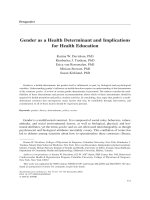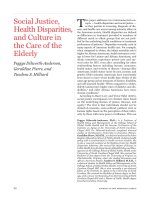gender and sex gender sex and culture the importance of gender roles defining gender as already detailed sex is about the physical attributes of women and men gender is about the cultural attribute
Bạn đang xem bản rút gọn của tài liệu. Xem và tải ngay bản đầy đủ của tài liệu tại đây (1.5 MB, 17 trang )
<span class='text_page_counter'>(1)</span><div class='page_container' data-page=1>
Gender, Sex, and Culture
</div>
<span class='text_page_counter'>(2)</span><div class='page_container' data-page=2>
<b>Defining Gender</b>
As already detailed, sex is about the physical attributes
of women and men.
Gender is about the cultural attributes derived from the
biological differences between the sexes.
The second sociological constant of kinship is male
dominance.
Once considered widespread, the assumption of male
dominance, recent research suggest, is problematic
and is more statistical than absolute.
After looking at the male dominance question, we
examine the gender division of labor and its
</div>
<span class='text_page_counter'>(3)</span><div class='page_container' data-page=3>
<b>The Question of Male Dominance</b>
In a project on matrilineal descent, David Schneider
and Kathleen Gough with others used male dominance
as a working assumption: How can societies that trace
their descent through females accommodate males in
whom authority over the group is vested.
They sought, and in some cases found, ways whereby
men have an interest in their sisters’ reproduction
although incest tabus prevent them from mating with
them.
Recent research suggests that in many societies,
women played greater roles of authority than
previously thought.
</div>
<span class='text_page_counter'>(4)</span><div class='page_container' data-page=4>
<b>The Question of Gender Status: A </b>
<b>Short History</b>
<b>In the nineteenth century, evolutionists </b>
<b>such as Lewis Henry Morgan postulated a </b>
<b>four-stage model of society:</b>
<b>The first stage was sexual promiscuity</b>
<b>The second stage was matriarchy; it was </b>
<b>evident who the mothers were but not the </b>
<b>fathers</b>
<b>The third stage was patriarchy: by Roman </b>
<b>times the father owned the wife and the </b>
<b>children as property.</b>
<b>The fourth stage was the nuclear family of </b>
<b>Victorian England and the “modern” U.S., </b>
<b>the hallmark of civilization. </b>
<b>Recently, Evelyn Reed has documented </b>
<b>the case for this phase of human history in </b>
<i><b>her Women’s Evolution from Matriarchal </b></i>
<i><b>Clan to Patriarchal Family. That issue </b></i>
</div>
<span class='text_page_counter'>(5)</span><div class='page_container' data-page=5>
<b>Cases of Male Dominance: The Masai </b>
<b>of Kenya</b>
<b>The Masai are a pastoral society, </b>
<b>exclusively herdsmen.</b>
<b>Men own the cattle, and also the women </b>
<b>they procreate and marry as chattel </b>
<b>property.</b>
<b>Women do all the work around cattle—</b>
<b>milk them, draw their blood, use their </b>
<b>dung for construction material, and a </b>
<b>host of other jobs. (upper photo)</b>
<b>Theirs is a polygynous society (one male, </b>
<b>two or more females), and the women </b>
<b>move to the men’s residence at marriage.</b>
<b>They own no property; cattle pass from </b>
<b>father to son.</b>
</div>
<span class='text_page_counter'>(6)</span><div class='page_container' data-page=6>
<b>Cases of Female Influence: The !</b>
<b>Kung of Namibia and the Iroquois</b>
<b>Women elsewhere have much more say </b>
<b>in their society. </b>
<b>These !Kung gatherers contribute </b>
<b>around 80% of their bands subsistence; </b>
<b>because of their knowledge about </b>
<b>plants, their input in decisions where to </b>
<b>move to next is considerable. </b>
<b>Where women own property, they tend </b>
<b>to dominate the local households</b>
<b>Iroquois women were cultivators, owned </b>
<b>land and longhouses (interior depicted </b>
<b>in the lower picture), and so had much </b>
<b>influence in tribal affairs</b>
<b>They voted for council members, could </b>
<b>force removal of a member they didn’t </b>
<b>like, but did not sit on the council </b>
</div>
<span class='text_page_counter'>(7)</span><div class='page_container' data-page=7>
<b>The Question of Matriarchy: The </b>
<b>Zapotec Women of Juchitán</b>
<b>Another case study are the matrilineal Zapotec </b>
<b>of Juchitán, a Mexican village on the Isthmus of </b>
<b>Tehuantepec (top)</b>
<b>The women control the financial affairs of the </b>
<b>household; a household under the financial </b>
<b>control of men is a household headed for ruin.</b>
<b>Again they do not participate in council affairs. </b>
<b>The reason; the women say they have better </b>
<b>things to do than to argue about issues that </b>
<b>could be resolved in five minutes</b>
<b>Yet they reject the idea that they are matriarchal; </b>
<b>they see themselves as administrators.</b>
<b>Women also contribute most of their household </b>
<b>income through marketing (bottom photo).</b>
</div>
<span class='text_page_counter'>(8)</span><div class='page_container' data-page=8>
<b>Division of Labor: Background</b>
In nonindustrial communities, almost all
households are involved in the primary
sector: agriculture, herding, foraging.
The main divisions of labor are based on
gender, age, and part-time crafts.
</div>
<span class='text_page_counter'>(9)</span><div class='page_container' data-page=9>
Gender Division of Labor:
Definitions
The gender division of labor may be defined as an
arrangement whereby men perform some tasks
and women others.
Three basic questions are related to this division:
Does every society have different work for males
and females? The answer is generally yes.
Do the women and men divide work in similar
ways? It depends on the society, its environment,
and its technology.
</div>
<span class='text_page_counter'>(10)</span><div class='page_container' data-page=10>
Gender Division of Labor:
Gender-Exclusive Tasks
<b>Men generally handle heavier tasks that </b>
are often dangerous.
They generally engage in warfare and
usually exercise political leadership
<b>Women generally handle domestic duties </b>
and rear children.
</div>
<span class='text_page_counter'>(11)</span><div class='page_container' data-page=11>
Gender Division of Labor:
Shared Tasks
Either or both genders perform handicrafts:
weaving, leatherworks, pottery, basketry,
and others
Both genders tend and milk cattle and
other herd animals, plant the fields, tend
them during the growing season, and
harvest the crops
</div>
<span class='text_page_counter'>(12)</span><div class='page_container' data-page=12>
<b>Gender Division of Labor: </b>
<b>Explanations</b>
There have been three main categories of
explanations to predict how labor is allocated
cross-culturally
<b>Strength explanations attribute heavier tasks to </b>
the males’ relative superior strength.
<b>Compatibility-with-child-care explanations </b>
have women handle tasks that can be interrupted
<b>Male expendability explanations: a group can </b>
</div>
<span class='text_page_counter'>(13)</span><div class='page_container' data-page=13>
<b>Strength Explanations</b>
Men are said to be able to mobilize
strength in quick bursts of energy
Matches most tasks done by males,
including hunting, clearing land (upper
left), and heavy construction.
</div>
<span class='text_page_counter'>(14)</span><div class='page_container' data-page=14>
Compatibility-with-Child Care
Explanations
Women handle tasks compatible with
child care (especially at
breast-feeding)
Tasks are interruptible to tend to child
(such as cultivating local fields); tasks
do not take them away for long
Tasks do not place children in danger.
However, most of the marketers are
women, who spend a long time away
from home (such as these
Guatemalan natives).
</div>
<span class='text_page_counter'>(15)</span><div class='page_container' data-page=15>
Male Expenditure Explanations
Men usually engage in
dangerous work (or warfare)
Loss of men is less
disadvantageous to society’s
survival than loss of women,
who have reproductive power
Shortcomings: Women also
take on dangerous tasks
Atga (Philippines): Women
hunt (lower left)
</div>
<span class='text_page_counter'>(16)</span><div class='page_container' data-page=16>
Gender Division of Labor:
Evaluation of Explanations
We have seen in this series that most, if not all
explanations, account for all cases.
This applies to all generalizations in the social
sciences.
We are dealing with volitional beings, and the job
of anthropologists is to develop further hypotheses
to explain the exceptions—or come with new
hypotheses to better explain the facts.
</div>
<span class='text_page_counter'>(17)</span><div class='page_container' data-page=17>
Conclusion
Sex is the first organizer of human society
This is filtered culturally through gender
Gender labor and status depends on
cultural factors
</div>
<!--links-->









